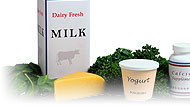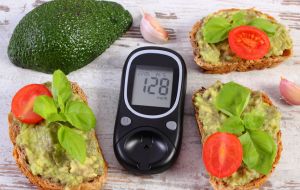Dairy-Free Diet

Why Do People Follow This Diet?
Most people who follow a dairy-free diet are allergic to dairy products. However, a few people who are exquisitely sensitive to lactose—milk sugar—also need to avoid all dairy products.
People who react to lactose are called “lactose-intolerant.” They lack adequate amounts of an enzyme (called lactase) needed to digest milk sugar. Unlike people who are allergic to dairy products, most lactose-intolerant people can consume dairy products that naturally contain only traces of lactose (such as hard cheese) or those that have been treated to break down lactose (e.g., Lactaid™ milk). Many lactose-intolerant people can also eat yogurt without suffering, despite the high amount of lactose found in yogurt. The ability of many lactose-intolerant people to consume yogurt without getting sick used to baffle scientists. Now we know that the bacteria in most yogurt products (except frozen yogurt) consume most of the lactose as soon as the yogurt moves from the stomach to the intestines. These bacteria are so efficient that they often break down the lactose before the lactose-intolerant person has a chance to react to it.
Milk allergy is an immune system response to the presence of milk protein in the body. The body perceives the protein as “foreign” and proceeds to mount an attack against it, which results in the symptoms of an allergic reaction. Cow’s milk is the most common cause of food allergy in infants and young children. Cow’s milk proteins are potent allergens and around 2.5% of infants experience cow’s milk allergy in the first years of life. However, food allergies usually diminish with advancing age. Up to 85% of children will outgrow their allergy by the age of three; the majority will outgrow it by the time they reach school.
Symptoms
The symptoms of lactose intolerance occur within a few hours of ingestion of milk or milk products and include bloating, abdominal pain, gas, and diarrhea. The severity of lactose intolerance varies greatly among individuals. Lactose-intolerant people who experience these symptoms even when they eat only dairy products that contain very little lactose may require a diet free of all dairy products to avoid these symptoms.
Milk allergy symptoms may include any of the common symptoms of food allergies, including skin rashes or hives, gastrointestinal distress, breathing problems, or many other possible symptoms. Anaphylaxis, a life-threatening allergic reaction, is only rarely triggered by consumption of dairy products, even in people who are allergic to dairy.
Copyright © 2025 TraceGains, Inc. All rights reserved.
Learn more about TraceGains, the company.
The information presented by TraceGains is for informational purposes only. It is based on scientific studies (human, animal, or in vitro), clinical experience, or traditional usage as cited in each article. The results reported may not necessarily occur in all individuals. Self-treatment is not recommended for life-threatening conditions that require medical treatment under a doctor's care. For many of the conditions discussed, treatment with prescription or over the counter medication is also available. Consult your doctor, practitioner, and/or pharmacist for any health problem and before using any supplements or before making any changes in prescribed medications. Information expires December 2025.















